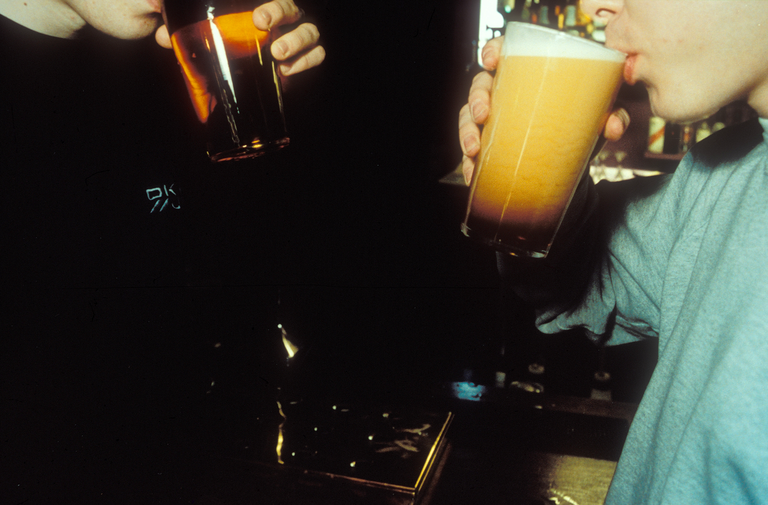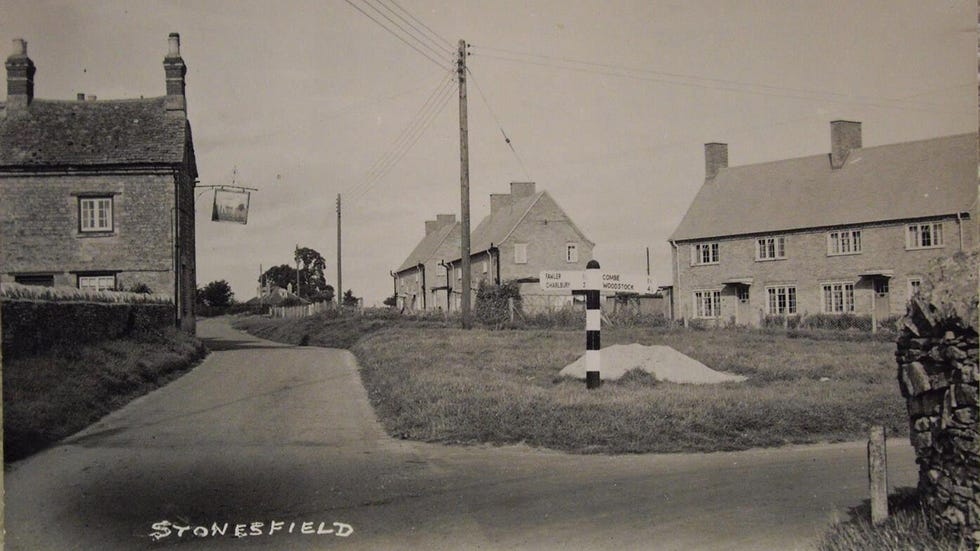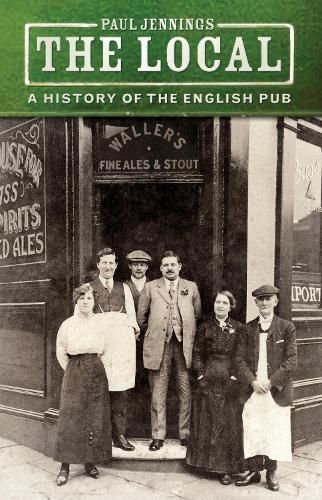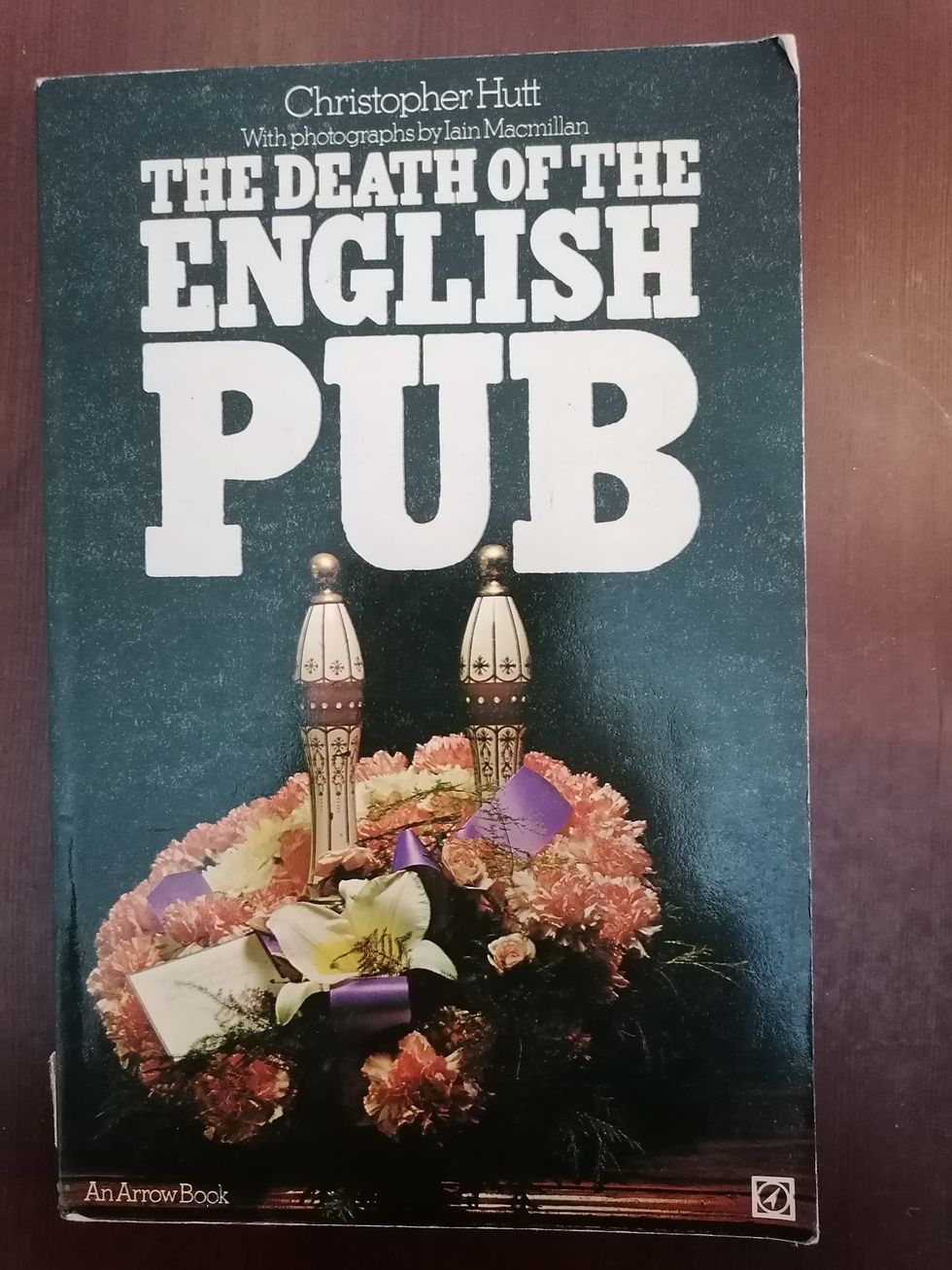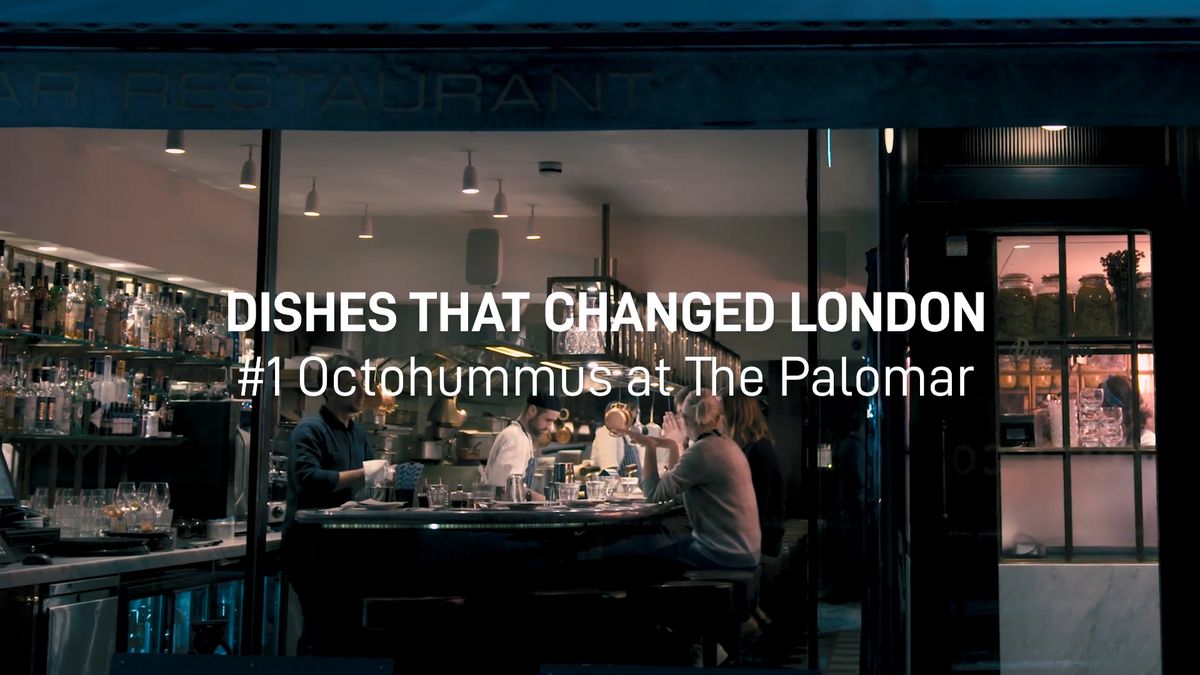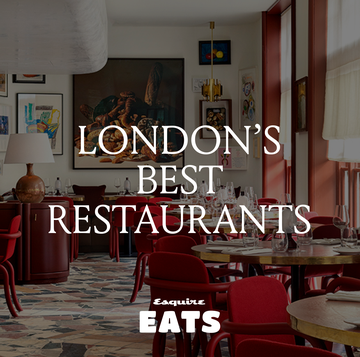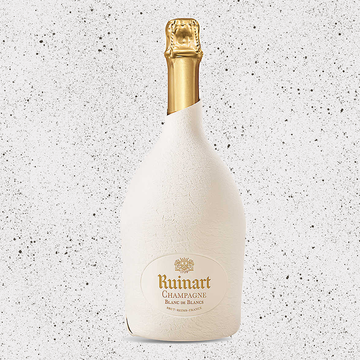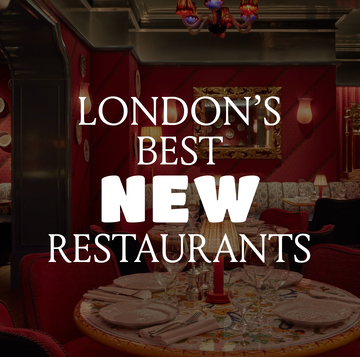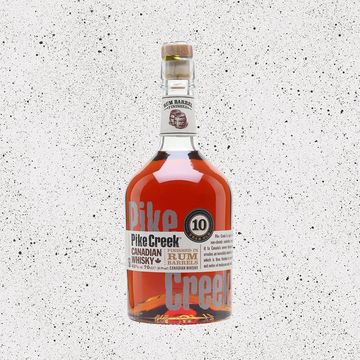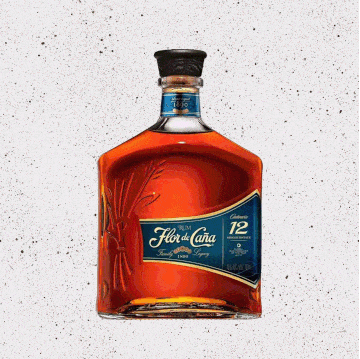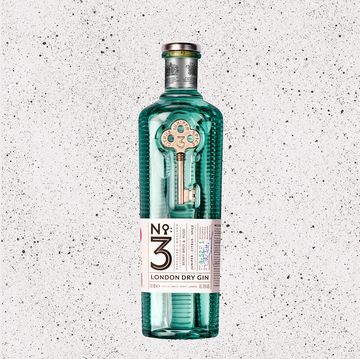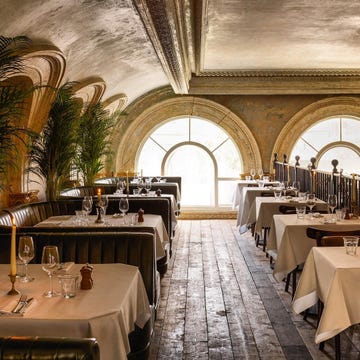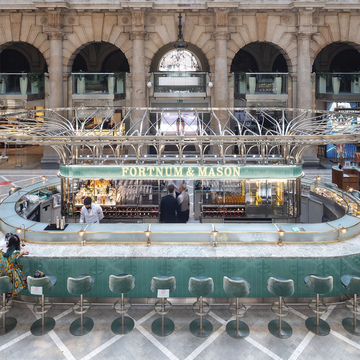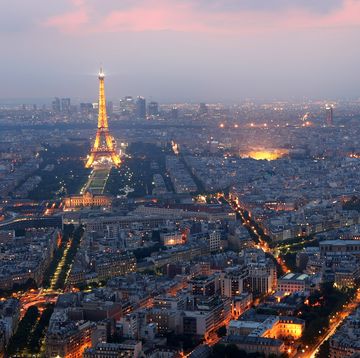Outside the White Horse in Stonesfield, on a triangular green island in the middle of three roads, there’s a gigantic horse chestnut tree.
We’re in Soho Farmhouse territory here, deep in the Oxfordshire Cotswolds. Stonesfield is a one-bus-an-hour sort of place. It’s the last day of September and slightly chilly, and there’s a windfall of conkers underneath the tree. The smell of wood smoke drifts over the village. In a bus shelter on the green island, a laminated poster advertises the new Stonesfield Village website. “What’s new in the village?” it asks over a stock image of hands typing on a keyboard. “Log on to discover more.”
It’s Saturday afternoon and a steady stream of people walks past the tree and into the White Horse pub. It looks a little like a farmhouse, with walls made of unevenly shaped and sized lumps of stone and elegantly bowed beams inside. The bit of the beer garden where some ground-burrowing bees live is cordoned off. “BEE-WARE,” says the sign. “BUZZ OFF.”
There used to be seven pubs in Stonesfield but, one by one, they closed. Three and a half years ago the White Horse, the village’s last, closed for a lockdown and never reopened. Now, after selling shares to 600 locals and about 400 people from further afield, the pub has been acquired by the people of Stonesfield. Three weeks after buying it outright, a team of about 90 locals scrubbed, painted and polished it back to life.
Claire Renshaw takes a breather behind the bar after lunch service. She’s the chair of the White Horse committee, and this weekend sees the first in a run of pop-up pub sessions to reintroduce it to the village. “WE ARE ALL VOLUNTEERS PLEASE BEAR WITH US,” pleads a chalkboard on the bar. “I didn’t have anything apart from cashews and pork scratchings to eat yesterday,” she says, halfway through a bowl of soup.
She’s lived in Stonesfield for 13 years, so is “still a blow-in”. Life here, she says, was very boring without the pub. The White Horse has been hit by pretty much every problem pubs at large have experienced — unpredictable landlords, threats of development, Covid, building owners making puzzling decisions, everything being incredibly expensive — and now people are making its soup, baking its bread, tidying its garden, sweeping its floors and pulling its pints. The vibe is one of frazzled, manic excitement.
Defining what a pub actually is can be tricky. The Campaign for Real Ale (Camra) definition of a pub runs to four main principles, with four extra subsections and six additional notes. The key points are these: pubs don’t charge for entry, or require you to be a member to drink there; pubs serve at least one draught beer or cider; pubs allow you to have a drink without buying food, and have at least one area set out just for drinking; and pubs let you buy drinks at a bar without waiting for table service.
The other key pub thing is that they have to be in the UK or Ireland. Bars are everywhere. Pubs are not. That’s why it stings when we fear they might vanish. They’re a link back to the inns that dotted pilgrimage routes through the Middle Ages. Pubs as we know them boomed after 1830 when, in an effort to wean Britain off the strong gin it had become hooked on over the previous century, the Beerhouse Act got rid of beer tax, let taverns, alehouses and pubs open longer and made it easier to get a brewing licence. If you see a pub named after William IV, who was on the throne at the time, that’s why.
The White Horse is a rare bit of good news for pubs. The death of the Great British pub has been declared quite often in the past couple of decades, but things are particularly acute now. In 1980 there were 69,000 pubs in the UK; Camra puts the number open today at 46,805. There was a big dip after the smoking ban in 2007, and another one after the pandemic. That, most pub experts I speak to suggest, got people out of the habit of going to the pub and sent them to the supermarket instead. Nearly 400 shut in the first eight months of 2023, a rate of nearly two a day.
The idea of losing them is painful enough that a village will pull itself together to bring one back from extinction. We often think of pubs as the last bastion in the fight against the draining drudgery and complexities of modern life. The pub is where a version of Britain we really like always has a spot at the bar: outgoing, friendly, up for a laugh, moist-eyed about tradition, three pints deep, the kind of country that buys a bag of crisps and splits it open so the whole table can have some.
They’re something people know about us, like red phone boxes and Beefeaters. (It’s always interesting to see which features survive the translation abroad. On a visit to Los Angeles, a guide pointed out a “British pub” on Sunset Boulevard. I looked up at the sign. It was named after a slur against Travellers. We got tacos instead.)
And, look: it’s not pretty out there. Now that the £7.50 pint stalks city centres across the UK, a big night out is a big investment. A lot of pub landlords are clinging on. When Jaega Wise, head brewer at Wild Card Brewery and landlady of the Tavern on the Hill in Walthamstow, says things are “extremely difficult right now,” it’s something of an understatement. People hang out in barbers’ shops, in shisha bars, at the gym, online, round each other’s houses with all the films and TV, ever, to watch. So why should the pub survive?
This is how the pub-doomer case goes. The numbers really aren’t great. It’s more expensive to have the lights on — a chalkboard outside the Split Chimp micropub in Newcastle laid out why it had gone under in September this year, with rent up £10,450, and rates up by £27,000 a year — so pubs are less and less profitable to run and more and more expensive to drink in. Meanwhile, property prices steadily tick up, so pub landlords get chucked out, owners sell and pubs are turned into estate agents and flats and supermarkets. Every town has heard dark mutterings about strange fires and sudden demolitions. Famously, the Crooked House in Staffordshire burned down last August and was a pile of rubble within days; so far six people have been arrested and bailed in connection to it. The anger that the Crooked House case inspired — local MP Marco Longhi called it a “tragedy” in the House of Commons — came from the apparent brazenness of it all, and from people remembering pubs they’d lost themselves.
“I think we’d always like to think we’re approaching the bottom of the curve and we’ll see it increase again,” says Tom Stainer, chief executive of Camra. “But I think, with my pessimist’s hat on, we might be seeing some more closures in the next couple of years. The winds that are against pubs seem particularly gale force at the moment.”
One of the problems is that when we talk about The Death of the Great British Pub, the pubs themselves get lost on the way. They’re often a way of moaning about something else. There’s usually some under-the-breath tutting about how strait-laced and boring the WFH generation is, and a more serious mistrust of developers, speculators and foreign investors carving away bits of public life for themselves.
Sometimes it feels like an offshoot of what the writer Dan Hancox calls “binmenism”, named for boomerish Facebook memes that reminisce about how, back in their day, proper binmen carried proper bins. These Zoomers — too busy with their TikToks and their fidget spinners to smash seven pints at lunchtime — will be the death of all we hold dear. And the anger and sadness that usually meets the closing of another pub doesn’t match up with an enthusiasm for going to the pub, which would have prevented the pub dying in the first place.
“You have to try not to be too frustrated,” says Stainer, “but if everyone who complained about the local pub shutting had been using it regularly, the local pub probably wouldn’t have shut. But I think it speaks to the importance that pubs have in communities, even for those who don’t regularly use them.”
People still want pubs, says Wise: “You do see people coming, but it’s just the amounts they’re spending and the amount of drinks they’re having [that has changed].” Three or four pints and a meal is now one or two pints. Stainer keeps calling for business-rate reductions and beer duty, to help pubs drop prices.
The general feeling among pub owners and pub lovers is deep alarm. Their outlooks range from que sera sera fatalism to near-traumatised. The glass isn’t just half empty; the half that’s left is flat, and there’s a cigarette end floating in it. There are some less downcast publicans. Rob Gutmann is a hospitality veteran of 30 years, and has opened four pubs in Liverpool in the past two years. Times are tough, he admits. “But quite frankly, a lot of British pubs have just got very bad at doing what they were meant to be doing, I think. They weren’t trying to win new markets. They weren’t thinking about it.”
The pub has died a lot of deaths. “You can’t really say that there’s been a static pub culture, something that we’d always recognise,” says Paul Jennings, author of The Local: A History of the English Pub. It is, he says, a mutable, evolving thing. In the 1990s, for instance, chef David Eyre and manager Michael Belben moved into the Eagle in Clerkenwell, central London, and brought a River Cafe-influenced menu along with them. It was the UK’s first gastropub. Now it feels like nearly all pubs owe something to the Eagle, whether they’re built from foundations to thatched roof around local produce on chalkboards, or rotate through semi-permanent pop-up kitchens, or just do a fancy Scotch egg and Tyrell’s crisps rather than grey sandwiches and Scampi Fries.
It doesn’t always work. The White Horse in Stonesfield went gastro under one set of former owners, and did quite well for a while until trade dried up and it was shuttered again. The gastropub did transform what the traditional pub could be, though.
In fact, we’ve been mourning the pub as we imagine it — the hearthside of the community, a home away from home, a place where everybody knows your name and they’re always glad you came, etc — for the past century and a half.
Christopher Hutt’s beautifully miserable book The Death of the English Pub sounded a warning in 1973. Hutt raged against bad beer, weak beer, poorly kept beer, bad makeovers, unscrupulous landlords, unscrupulous politicians and unscrupulous breweries.
“The nature of most of the pubs that we know and have used has been changed out of all recognition in the past 10 years and the bulldozer still seems to be gathering power and pace,” he wrote, before having a meltdown about raspberry-flavoured beers.
Out in the shires things weren’t much better. In Akenfield, Ronald Blythe’s late 1960s study of village life, pub-goers grumble about the youth of today not taking their drinking seriously. “Before this generation, a countryman went into his pub to have a damn good session — it was their pleasure, wasn’t it?” said a 44-year-old agricultural educator. “But the young men hardly drink at all.”
Both that agricultural educator and Hutt had apparently missed the pub’s halcyon days too, though. In 1943, the Mass Observation social-research project found that Bolton’s pubs weren’t what they had been. “The pub today plays a smaller part in the life of the town than it ever did,” anthropologist Tom Harrisson wrote.
In fact, people have been mourning the death of proper pubs for almost as long as there have been pubs. In 1857, a correspondent for Building News got lost in a reverie about old-style pubs with long benches and dark corners. “Tonight it is otherwise — the corner public is radiant of gas, redolent of mahogany, and glittering in mirrors, there are no settles, no stools nor an easy smoking with hard drinking.”
The best days of the pub are permanently a generation or so ago, when people knew their neighbours, you could leave your door unlocked and life was simpler. For Jennings, that view of pubs as “stuck in some sort of Dickensian thing where there’s a big glowing fire and they’re just bringing out the roast beef and what have you,” was never really the truth.
It’s obviously bad that going to the pub is a luxury in a way it never was before. But the pub isn’t just being squeezed by things making Britain worse right now; over the past 60 years it’s been squeezed by things making it better too.
It’s good that people don’t drink on their lunch breaks anymore. It’s good that people want to be with their partners and kids at home. It’s good that fewer people need a bright, warm place to escape their Dickensian hovel. It’s good that you don’t have to schlep to the office five days a week anymore. It’s good that you can’t drink and drive. And it’s extremely good that more and more people are happy to point out when pubs make certain groups feel unwelcome.
“We have this sort of harking back to the golden age of pubs, but I’m not sure that they always were [great],” says beer journalist Emma Inch. “Not for a lot of people, anyway.”
That familiar idea of the pub as the place where everyone is welcome and everyone gets on is nice, but often a fantasy if you’re not a straight white bloke.
When he first started going to pubs, the writer David Jesudason remembers being the only non-white guy in them: “It was horrendous.” White pub-goers mockingly called him a taxi driver.
“And I kind of just tolerated this,” he says. “That was the only way to get a drink really. As I grew up I found better places. I liked going to the centre of London, but I’d never really been to majority-brown places or places that were really mixed or diverse until I went to a Desi pub.” He’s British-Asian himself, and he still gets condescended to sometimes. “Even as a beer writer, I feel quite intimidated going to a bar because I often get… let’s call it white-splained, what the beers are.”
The first Desi pubs were opened in the 1960s by landlords of Indian heritage to get around the colour bars, which still operated illegally in some pubs up to the 1980s. Since then, they’ve quietly been one of pub culture’s great successes: pubs that serve sensibly priced Indian food alongside beers. While writing a new guide to Desi pubs, Jesudason visited pubs all over the country. Broadly speaking, white landlords were fairly despondent; Desi-pub landlords were more pragmatic. Desi pubs were an early pointer that pub culture had to change, and could find a new lease of life in the process.
“Diversity often happens when customers are needed,” Jesudason says, and points to the whiteness of the buoyant craft-brewing scene. The pubs of 40 years ago could afford to ignore people who weren’t white because they had a solid customer base: “If they’re doing very well for custom, they don’t need to reach out to the wider community.”
Women have always gone to pubs, but pubs now aren’t the overwhelmingly male spaces they once were. “I think we’ve lost some of those social structures that forced that to happen,” says Inch. “And some of that’s for the best.” When Wise started going to pubs in Nottingham less than 20 years ago, her friend told her to order halves because pints weren’t ladylike. “And I did it. I did it for years!” She’s long since stopped.
“There’s been a massive shift, I think, across the beer industry generally to force a change in quite a short space of time, and I think that has largely shown up in pubs,” says Wise. “And there is a long way to go with regards to that, but there’s certainly been an improvement in my time.”
They’ve generally been very straight spaces too. “Sometimes we get this rose-tinted line that, oh, everyone’s welcome in every pub, or pubs welcome everyone; whoever you are, you can stand at the bar with all different walks of life,” she says. Pubs were where she and her peers shared information about HIV and Aids and Section 28; now groups organise online. Inch describes herself as “a butch dyke”, and she doesn’t feel welcome everywhere.
“I still do a quick scan of any pub that I go into. Does this feel welcoming? Am I OK here? And there’s certain places that I wouldn’t necessarily go to because I don’t feel safe to be there.”
The supposed golden age of the pub might have gone, says Inch, and maybe that’s OK. “Trying to recreate that I think is…” She looks for the word. “It’s not appropriate. But I honestly think that pubs can and do and have evolved, and that they can continue to do that and stay relevant.”
The crisis has to bring solutions, Liverpool publican Rob Gutmann thinks. “It has been a really testing time, but what are you going to do? You’ve got to face forward and come up with some new ideas, guys. It’s as simple as that.”
Tuesday morning is grey and blustery, and it’s quiet in the bar of the Salisbury Hotel. The Salisbury was built on Green Lanes in Harringay, north London, during the late-Victorian pub boom, as a gigantic pub-slash-hotel and restaurant. From the outside, it looks like a castle. Inside, it still has its old finery: columns with ornate capitals at the top, deep-red walls and a vast, rectangular wooden bar you can walk all the way around. There are still a couple of hours before opening, and it’s quiet and still, like a library. It has nooks, and comfy, knackered sofas, and two cats, Tequila (tabby, tubby, terrified) and Bulleit (black and white, ancient, unbothered) padding around.
Twenty years ago it collapsed into disuse, then reopened and tried again. Now it’s the model of a modern London pub: the old restaurant room hosts stand-up comedy and life-drawing classes, and the kitchen turns out Chinese food through the week and upscale roasts on a Sunday.
David Lewis is the manager, and has been here for nearly two decades. He’s softly spoken, with short, greyed hair, and takes his time answering questions in a gentle South Welsh accent. We sit on a very long, very squishy kind of pew looking out from the wall furthest from the front door. Bulleit crumples slowly into a heap on the long table in front of us.
The outlook is uncertain. “But I think, in London,” says Lewis, “we’re in our own bubble, and if you’re doing the right things for the community, then pubs will keep on going. If you stop and don’t adapt, then you’re going to end up stagnating and maybe not doing as well.” The Salisbury dropped its club nights and started hosting charity events and kids’ days, and added four non-alcoholic beers to the taps along with a coffee machine.
A survey of villagers told the White Horse committee what they wanted: “Good food, and a café during the day, quiz nights, a craft fair, all sorts of things.” They’ve got three types of dairy-free milk in the fridge. Like the White Horse, the Salisbury has found that the way through is to become a multi-hyphenate space, to absorb all of the good stuff that was pulling people away from pubs — high-end food, non-alcoholic drinks, live entertainment — while hanging onto what pubs have always had.
More and more bits of modern life feel tightly controlled and siloed off. But pubs are still places where you can sit and have nobody bother you for a few hours, and they’re still places where different generations collide. Claire Renshaw remembers bringing her kids to the White Horse, where they now help out alongside their mum’s generation; at Jaega Wise’s pub, they’ll check in on certain older regulars if nobody’s seen them for a couple of days.
And the thing that pubs still have over anywhere else is the sheer serendipity that those two things generate. Outings to restaurants, gym sessions, cafés are all pretty finite. Pubs are freewheeling, open-ended places. “It has this thing of people mixing fluidly. It comes from chat,” says Jesudason. “It comes from the bar. If they all sat down on individual tables, none of this would happen.”
“Pubs are pretty magical places where the whole of life happens: funerals, weddings, birthdays, breakups, people getting together,” says beer writer Matthew Curtis, author of pub guides to London and Manchester. “But the beauty is that you can also sit there for a few hours and nothing could happen at all. I can’t think of any other place quite like them, to be honest.”
In the Salisbury, David Lewis thinks. “As for the death of pubs…” He mulls it over. “I don’t think we’ll see it in our lifetime. I think pubs can still offer something for the community, especially [when they are] this big with the function room and everything. But yeah, I don’t, I can’t see it happening.” He pauses. “Then again, it depends how much the prices go up again.” Bulleit slowly unfurls his skinny frame and drops to the parquet floor. Tequila whistles past on her way to somewhere quieter.
Nobody’s under any illusions about the future. In Stonesfield, the bees burrow into the turf. The volunteers will run the pub until next summer, then hand it off to a new landlord. For the time being, Renshaw is just looking forward to Christmas Day, when hundreds of people should come by, like they used to when she had just moved in.
“It’s absolutely amazing, honestly,” she says. “I really miss that.” ○
